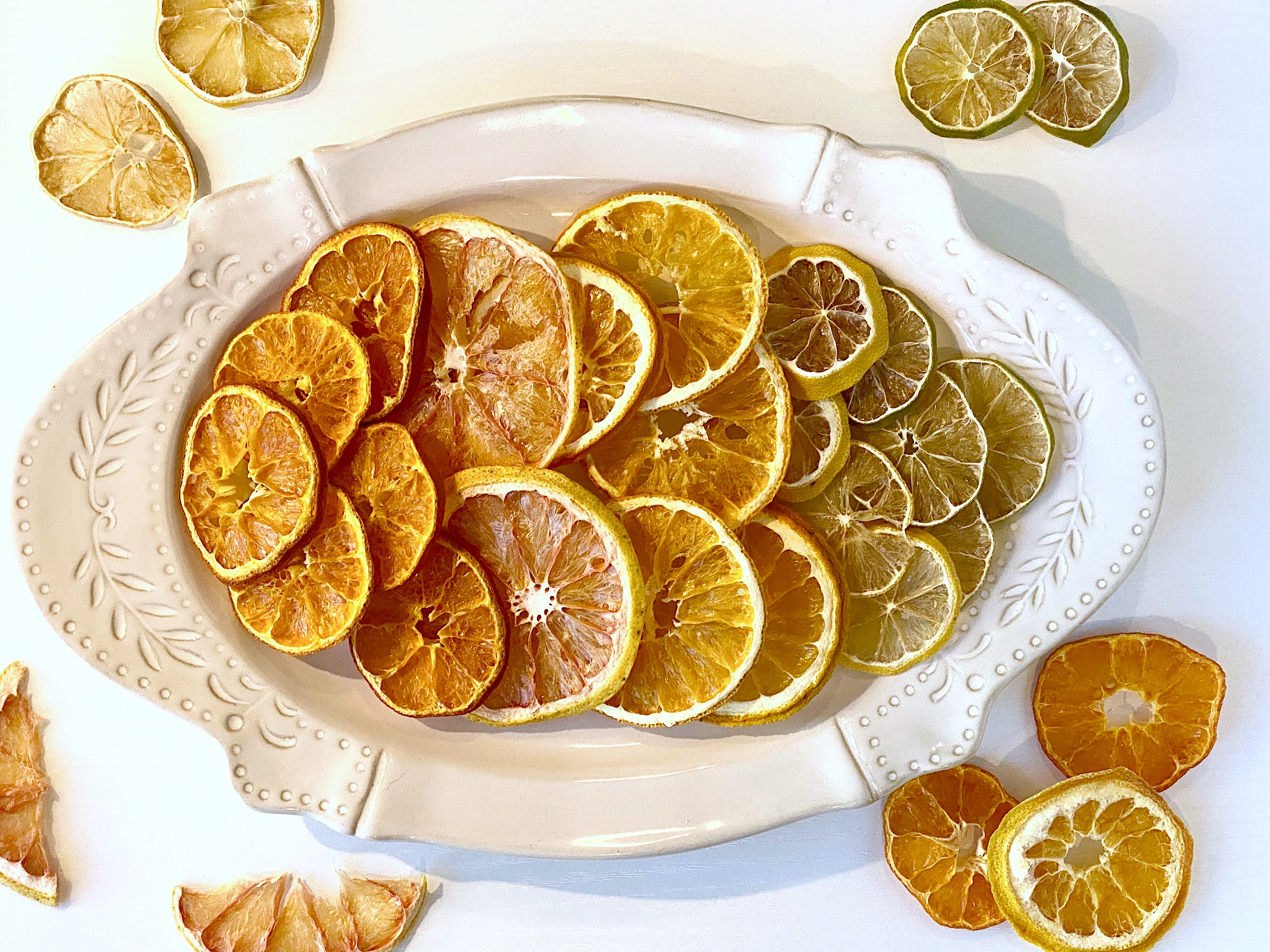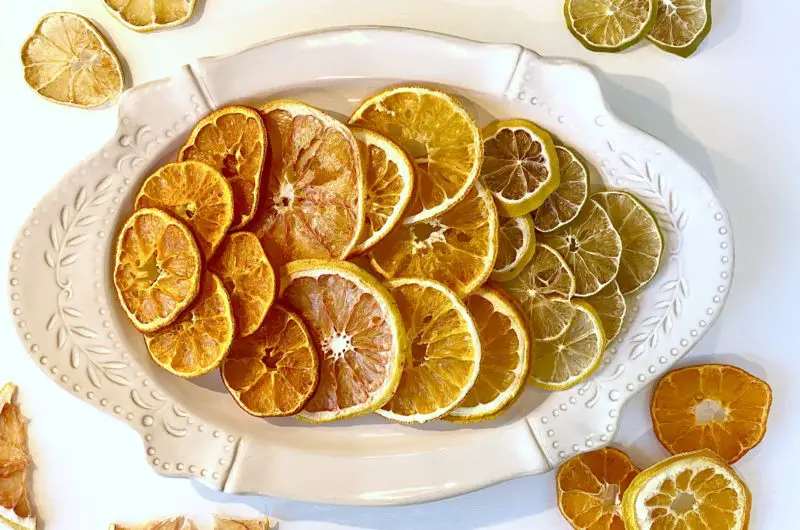With the end of October and Halloween and the start to the cooler nights and citrus season, I thought it would be fun to teach you how to dehydrate fruit for teas, mulled wine, flavored water, and more!
For the purpose of this blog post, I used grapefruit, lemons, limes, tangerines, and oranges. You can use any citrus you like! Dehydrated berries also work well in drinks.
Why Eat Citrus?
Generally, citrus fruits contain high amounts of vitamin C. I am not a doctor, nor do I claim to be an expert. That being said, it is a well-known fact that vitamin C helps to combat illness, manage heart disease, and repair UV damage to your skin. (Important Note: Vitamin C helps FIGHT a cold, not prevent it!)
Further, citrus is an excellent source of vitamin A, vitamin B, and potassium. Overall, citrus is a delicious and healthy snack!
Why Dehydrate Food?
Dehydrating food at home is nothing new. Long before efficient mass production and access to grocery store chains, generations of families dehydrated and dried food as a method of enhancing/changing the flavor and preservation. After all, before refrigeration, how else would one preserve food besides pickling and canning? (Speaking of pickling, try our homemade maneul jangajji, otherwise known as Korean pickled garlic.) How would one make it through long and cold winters when vegetation and game were scarce?

Think about jerky, sun-dried tomatoes, herbs, spices, and candied fruit. All of these common foods are dried and dehydrated. You consume more dehydrated food than you think!
Let’s Tackle Food Waste!
Besides keeping the cultural aspect of dehydration and preservation alive, why dry food? For me, most importantly, it comes down to food waste. Let us look at a lemon, for example. How long do lemons take to go bad sitting on your counter or sliced in your refrigerator? One week? Maybe two? Then, of course, the guilt sets in as you did not finish the entire bag of lemons before they started to mold. We have all been there!
Well, if you dehydrate a lemon, it will last an entire season sitting on your counter in an airtight container. Thankfully, you will no longer need to rush to consume or feel guilt when you accidentally let them sit there too long.
What do you use a dehydrated lemon for, you may ask? Try adding lemon when enjoying your morning cup of green tea, drinking a glass of water, or making a batch of holiday mulled wine. You can also drop it into a boiling pot of soup for depth of flavor, grind it into a powder and use it as a flavor enhancer in yogurt, or dip in chocolate to make a sweet treat. The ideas are limitless!
Just dehydrate to preserve for extended use. That way, you won’t have to worry about your mushrooms, potatoes, citrus, berries, or more going bad anytime soon! If you need to rehydrate, just let it sit in water for a while!
How to Dehydrate Citrus Fruit:
1. Wash Your Fruit in Baking Soda:
First, start by washing your fruit. Washing fruit is incredibly important as we will not remove the peels. Think of all the hands touching the fruit, the grime from transit, and the pesticides used. You don’t want to dehydrate all of those icky germs and chemicals along with your fruit!

To remove pesticides from fruits and vegetables, I recommend washing your fruit in a mixture of cold water and baking soda. For a large mixing bowl, you should add approximately 2 TBSPs of baking soda. Let your citrus fruit soak in the baking soda solution for 5 to 10 minutes.
Note: The method for cleaning your produce with baking soda differs depending on the fruit or vegetable. When cleaning something with a tough outer skin, let it soak in the water. Examples include produce such as apples, oranges, lemons, eggplant, and more. For produce without a tough skin, dip the fruit or vegetable in the solution quickly and rinse as to not create a soggy mess. Examples include berries, spinach, etc.
Studies have shown that most produce tests positive for residue of two or more pesticides. Baking soda actually helps to remove many of these pesky pesticides off the skin of fruits and vegetables!
Further Information About Cleaning Fruits and Veggies:
You can read further about this topic in this article from the Huffington Post. It contains some really interesting information. For example, did you know the statement on lettuce packages claiming your lettuce is “triple washed” is not a regulated claim or verified by the FDA? Amazingly, it is actually a marketing tactic and ploy. Think about it, how often are foodborne outbreaks related to leafy greens? OFTEN!!! So yeah, wash your lettuce and read the article.
Another short and simple article comes from “Health and Wellness Alerts” created by UC Berkeley School of Public Health.
Hopefully, I will have an article out soon discussing this topic further.

2. Slice Your Fruit:
After you wash and pat dry your fruit, thinly cut slices. Your slice should be between 1/8th- and 1/4th-inch thick. For those outside of America, approximately half a centimeter will do.
If you are slicing grapefruit and plan to use it in a mug with your water or tea, I highly recommend cutting it in half as well. Grapefruits are large. A whole slice may not fit well into your mug.
3. How to Dehydrate Fruit in the Oven:
When dehydrating citrus, preheat your oven to 175°F (approximately 79.5°C). Then, line your baking trays with parchment paper.
Place the sliced fruit on the trays. Do not let the fruit touch one another. Every few hours, rotate and shift the trays.
- Lemons: 4 to 6 hours
- Limes: 4 to 6 hours
- Tangerines: 5 to 6 hours
- Oranges: 6 to 8 hours
- Grapefruit: 8 to 9 hours
Unfortunately, dehydrating is not an exact science, especially with different types and performance levels of ovens. Because of this, it may take more or less time for your fruit to fully dehydrate. So, let me tell you what you are looking for:
The fruit should be completely dry. Your fingers should not get sticky with juice when touching the fruit. It will not be hard as a rock. Instead, you can expect the fruit to still be slightly pliable!

4. How to Dehydrate Fruit in a Dehydrator:
When dehydrating fruit, I prefer to use a dehydrator. A dehydrator guarantees better uniformity. Also, they are built to sit running for extremely long periods of time, often up to 24 hours. I can start dehydrating in the evening and peacefully sleep through the night with it running. Unfortunately, I do not feel safe doing the same with my oven.
If you do leave it running overnight, make sure to place it on a flat surface without anything laying on top, across, or near it. Let the machine breath!
I personally own an Excalibur dehydrator. Thankfully, there are dehydrators available for different price ranges. I’ve listed some below under my Amazon picks.
Place your sliced fruit directly onto your dehydrator shelves. Once again, do not let your fruit touch one another. Each slice should have its own space! Every few hours, rotate your dehydrator shelves. I also recommend changing the order.
Your dehydrator should be set to 135°F (approximately 57°C). Let all your fruit sit in the dehydrator for 12 hours. You can extend the time to 14 hours if you are not satisfied with how well your slices have dried.
Note: Sometimes the larger fruit, such as oranges and grapefruit, can take more time. If you check your smaller fruit, and it seems to be done, go ahead and remove it!
Add all fruit to the dehydrator at 135°F for 12 to 14 hours.
How Do You Use Your Dehydrated Citrus?
You can use dehydrated citrus in many different ways. As mentioned above, I most commonly use my dried citrus in tea, mixed in hot or cold water, and in mulled wine.
For those who also already do this, how do you use your dried fruit? Let us know in the comments below! Also, for those getting started, let us know how you like using dehydrated citrus as well. I promise this is a game-changer!
I also recommend getting some dehydrating books if you plan to make this a hobby like me! I’ve listed some books below!
Feel free to email us at [email protected] for any questions, recommendations, or stories. We love hearing from you!

You can follow us at @carvingajourney on Instagram, Twitter, Facebook, and Pinterest. Also, you can subscribe to our blog by joining our mailing list.
Carving A Journey is a participant in the Amazon Services LLC Associates Program, an affiliate advertising program designed to provide a means for sites to earn advertising fees by advertising and linking to Amazon.com. Although we may earn commissions for our endorsement, recommendation, testimonial, and/or link to any products or services from this website, these opinions are my own and I fully support these products.


